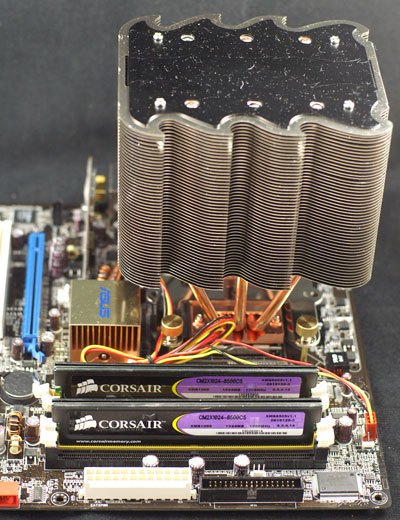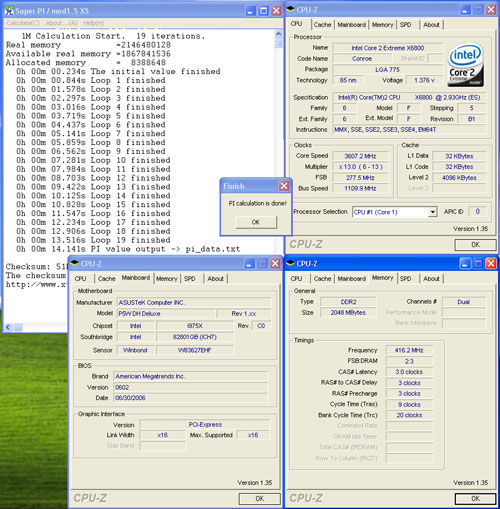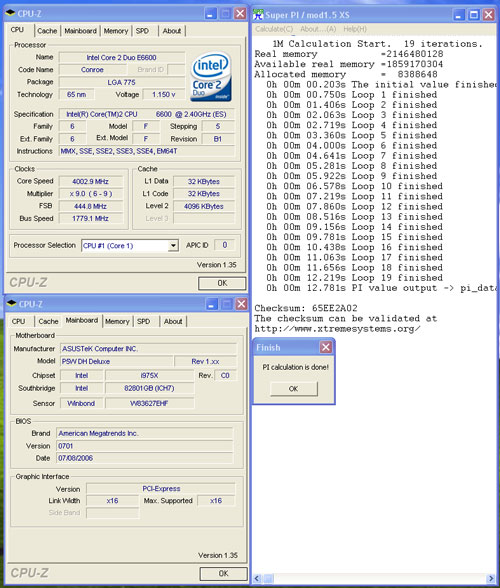Intel's Core 2 Extreme & Core 2 Duo: The Empire Strikes Back
by Anand Lal Shimpi on July 14, 2006 12:00 AM EST- Posted in
- CPUs
Overclocking
You have already seen that the Core 2 Extreme X6800 outperforms AMD's fastest processor, the FX-62, by a wide margin. This is exacerbated by the fact that the $316 E6600, running at 2.4GHz, outperforms the FX-62 in almost every benchmark we ran. That certainly address the questions of raw performance and value.
For most enthusiasts, however, there is also the important question of how Core 2 processors overclock. As AMD has moved closer to the 90nm wall, recent AM2 processors do not have much headroom. A prime example is the FX-62, which is rated at 2.8GHz, reaches 3GHz with ease, but then has a difficult time reaching or passing 3.1GHz on air. So how does Core 2, built at 65nm, compare in overclocking?
The top X6800 is rated to run at 11X multiplier on a 1066MHz FSB; it is the only Core 2, however, that is completely unlocked, both up and down. You can adjust multipliers up to 60 on the Asus P5W-DH motherboard, or down to 6. This makes the X6800 an ideal CPU for overclocking, even though top-line processors are normally notorious for not being the best overclockers.
To gauge the overhead or overclocking abilities of the X6800 in the simplest terms, the CPU speed was increased, keeping the CPU voltage at the default setting of 1.20V.
At default voltage the X6800 reached a stable 3.6GHz (13 x277). This is a 23% overclock from the stock 2.93GHz speed at stock voltage. It is also an important overclocking result, since it implies Intel could easily release a 3.46GHz or 3.6GHz Core 2 processor tomorrow if they chose to. It is clear there is no need for these faster Core 2s yet, but it does illustrate the speed range possible with the current Core 2 Duo architecture.
The X6800 was then pushed to the highest CPU speed we could achieve with Air Cooling. We did use a very popular and effective air cooler for our testing, the Tuniq Tower.

The goal was to reach the highest possible speed that was benchmark stable. Super Pi, 3DMarks, and several game benchmarks were run to test stability. The 2.93GHz chip reached 4.0GHz on air cooling in these overclocking tests. That represents a 36% overclock on air with what will likely be the least overclockable Core 2 processor - the top line X6800.
To provide some idea of overclocking abilities with other Core 2 Duo processors, we ran quick tests with E6700 (2.67GHz), and E6600 (2.4GHz). The test E6700 reached a stable 3.4GHz at default voltage and topped out at 3.9GHz with the Tuniq Cooler. The 2.4GHz E6600 turned out to be quite an overclocker in our tests. Even though it was hard-locked at a 9 multiplier it reached an amazing 4GHz in the overclocking tests. That represents a 67% overclock.
We had another Core 2 Extreme X6800 that we tried overclocking with a stock Intel HSF. The results were not as impressive as with the Tuniq cooler, with 3.4GHz being the most stable we could get it. We're going to be playing around with these processors more in the future to hopefully get a better overall characterization of what you can expect.
Curious about our overclocking successes, we asked Intel why Core 2 CPUs are able to overclock close to the same levels as NetBurst processors can, despite having less than half the pipeline length. Intel gave us the following explanation:
NetBurst microarchitecture is constrained by physical power / thermal limitations long before the constraint of pipeline stages comes into play. The microarchitecture itself would continue to scale upwards if not for the power constraints. (In fact, we have seen Presler overclocked to 6 GHz in liquid nitrogen environments. At that level, power delivery through the power supply & board itself begin to limit further scaling of the processor.)
Intel's explanation makes a great deal of sense, especially when you remember the original claims that NetBurst was supposed to be good for between 5GHz - 10GHz. NetBurst never got the chance to reach its true overclocking prime as Intel hit thermal density walls well before the 5GHz - 10GHz range and thus Intel's Core architecture was born. Intel's Core 2 processors once again give us an example of the good ol' days of Intel overclocking, where moving to a smaller manufacturing process meant we'd have some highly overclockable chips on our hands. With NetBurst dead and buried, the golden age of overclocking is back.
Enthusuasts have not seen overclocking like this since Socket 478 days, and in fact Core 2 may be even better. The 2.4GHz E6600, which outperformed the FX-62 in most benchmarks at stock speed costs $316, and overclocked to 4Ghz with excellent air cooling. With that kind of performance, value, and overclocking the E6600 will likely become the preferred chip for serious overclockers - particularly those that are looking for champagne performance on a smaller budget.
It is important, however, not to sell the advantages of the X6800 short. AnandTech never recommends the fastest chip you can buy as a good value choice, but X6800 does bring some advantages to the table. It is the only Conroe that is completely unlocked. This allows settings like 266(stock FSB)x15 for 4.0GHz, settings that keep other components in the system at stock speed. This can only be achieved with the X6800 - other Core 2 Duo chips are hard-locked - and for some that feature will justify buying an X6800 at $999. For the rest of us overclockers E6600 is shaping up to be the chip to buy for overclocking.












202 Comments
View All Comments
soydios - Friday, July 14, 2006 - link
Awesome article, as always from AT. Between the article and the 100+ comments above this one, almost all my Conroe questions have been answered.;)
johnsonx - Friday, July 14, 2006 - link
Wow is all I can say. I don't think there's ever been a performance jump quite like this. AMD will still do ok (not win mind you) on the low-end, where most people live, but the mid-range and high-end is so overwhelmingly in Intel's camp now there's just no comparison. AMD would have to go to 3.4Ghz+ to even be competitive (and still not win mind you).My office computers will continue to be AMD Sempron for the forseeable future (AM2 from now on of course), but next time someone wants a CAD box I don't see how I can quote anything but Core 2 Duo.
Also, loved the dinner table analogy on page 13.
crimson117 - Friday, July 14, 2006 - link
http://www.tgdaily.com/2006/07/13/dell_xps700_to_f...">http://www.tgdaily.com/2006/07/13/dell_xps700_to_f..."Grapevine (TX) - On the day Intel announces its next generation of Conroe desktop processors - which is expected within days - Dell Computer will upgrade its top-of-the-line XPS 700 desktop computer model to offer not only an overclocked Core 2 Extreme CPU, but also the option of two Nvidia GeForce 7900 GTX cards in SLI mode. These will apparently replace the Pentium Extreme processor and GeForce 7900 GS options currently available, and will be in addition to the Aegia PhysX accelerator already offered."
epsilonparadox - Friday, July 14, 2006 - link
Probably an Nf4 chipset since there are motherboards with conroe support using Nf4.Avalon - Friday, July 14, 2006 - link
This is one fine architecture. It wound up performing as well as I had suspected it would. Definitely wow.cgrecu77 - Friday, July 14, 2006 - link
I gambled by purchasing a A64 3700+ a few weeks ago when it dropped to under 150 ...If I were to upgrade to the cheapest solo I would probably have to pay 500 dollars or more (new cpu, mb and memory) and I will probably get ~ performance in games. I stopped overclokcing a long time ago (except for maybe 10%) because I am tired of my new system becoming unstable after 4 months (plus I don't really need it anymore since nothing I do is really cpu limited).
98% of people actually buy the cheapest CPUs in a range (A64 2800-3200, x2 3800, C6300). That's where the real competition will be and frankly I'm not impressed at all, A64 is an ~3years old processor and intel's newest product can only beat it by 20%? As far as I can remember the Athlon 3200+ was even worse in comparison to P4 3,2 Ghz and most people still bought the 2500+ Bartons ... So I wouldn't worry too much if I were an AMD stock holder, especially that it looks like Opterons still have no competition in the multi cpu servers (more than 2 ...).
After all, if Dell decided to use AMD NOW of all times it must mean something, they probably had access to these benchmarks a little earlier than Anand had ... :)
One thing I would have expected to see for such a new CPU that is supposed to carry the Intel flag for the next 2 years is 64 bit performance. This is probably the last year when 32bit OSes have the upper hand, starting with Vista most people will take advantage of their 64bit cpus. Once the majors concentrate on 64 bit drivers you can be sure that they will gradually take resource from the 32 bit development and the balance will shift very quickly ... If A64 has even a 10% advantage over the Cores combined with the .65 switch it will probably balance the equation to the point where core and a64 will have similar performance per clock ...
dargaard - Saturday, July 15, 2006 - link
http://babelfish.altavista.com/babelfish/trurl_pag...">Some Conroe problems (??) with 64 bitdev0lution - Friday, July 14, 2006 - link
First off, why mention Core Solo when it's totally unrelated to this article and any of the comments?
Second, socket 939's days are already numbered. You'd have to pay the same $500 to upgrade to the AM2 processors benched in the article, so mentioning this as a diss to Core 2 Duo is pretty weak.
So you'd have the option of spending $500 to upgrade to a E6600 setup that would beat out a $1200+ AM2 setup. Sounds like a no-brainer. And if you think AMD's going to slash prices below Intel's parts I don't think you can hold your breath that long.
And 98% of people don't even build their own computers, they buy tier-1... who aren't making nearly that percentage of their systems with the lowest end parts.
Looks like I'll have a 3200, 3700 and 4000 (939 parts) for sale in the near future...
MrKaz - Monday, July 17, 2006 - link
OK.But if you dont want to spent more than 120$ for the processor, the Conroe looks expensive.
aznskickass - Friday, July 14, 2006 - link
Dude, 20% is a HUGE margin when you are talking competitive benchmarks.When A64 was released back in 2003 it had about a 10% edge on the P4 and people were lauding it for it's leap in performance, and rightly so, considering the AXPs were getting beaten by 10%, so it was a 20% turnaround altogether.
This time around, it's even more impressive from Intel as they have turned a 10 - 20% performance deficit into a 20% advantage, you really can't expect much more than that, can you?
What did you expect Intel to do, double A64 performance? I'm sure if they ran their chips @ 4GHz/400FSB they might be able to get close to that, but what is the point when you have beaten your competition so convincingly already?